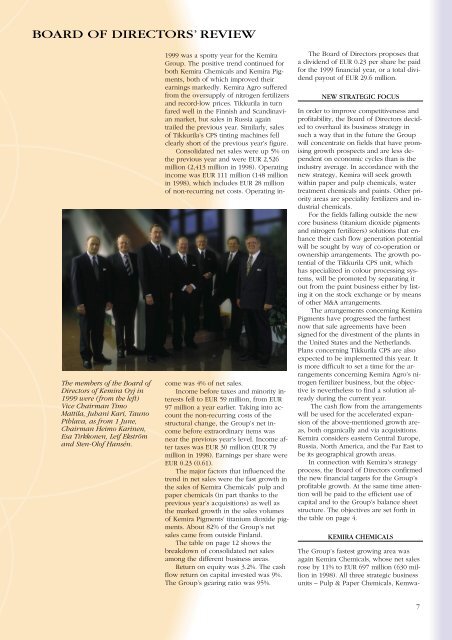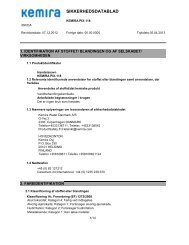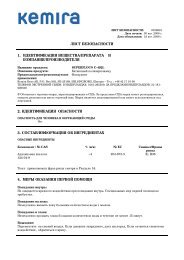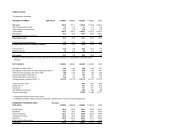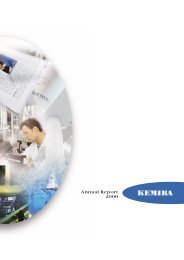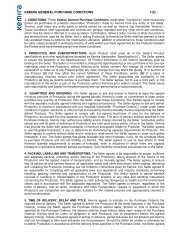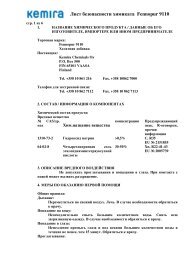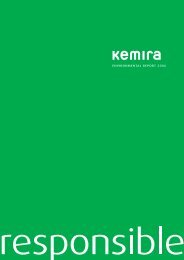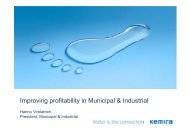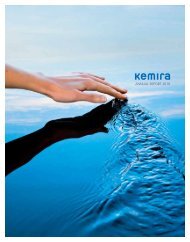Annual Report 1999 - Kemira
Annual Report 1999 - Kemira
Annual Report 1999 - Kemira
You also want an ePaper? Increase the reach of your titles
YUMPU automatically turns print PDFs into web optimized ePapers that Google loves.
BOARD OF DIRECTORS’ REVIEW<br />
The members of the Board of<br />
Directors of <strong>Kemira</strong> Oyj in<br />
<strong>1999</strong> were (from the left)<br />
Vice Chairman Timo<br />
Mattila, Juhani Kari, Tauno<br />
Pihlava, as from 1 June,<br />
Chairman Heimo Karinen,<br />
Esa Tirkkonen, Leif Ekström<br />
and Sten-Olof Hansén.<br />
<strong>1999</strong> was a spotty year for the <strong>Kemira</strong><br />
Group. The positive trend continued for<br />
both <strong>Kemira</strong> Chemicals and <strong>Kemira</strong> Pigments,<br />
both of which improved their<br />
earnings markedly. <strong>Kemira</strong> Agro suffered<br />
from the oversupply of nitrogen fertilizers<br />
and record-low prices. Tikkurila in turn<br />
fared well in the Finnish and Scandinavian<br />
market, but sales in Russia again<br />
trailed the previous year. Similarly, sales<br />
of Tikkurila’s CPS tinting machines fell<br />
clearly short of the previous year’s figure.<br />
Consolidated net sales were up 5% on<br />
the previous year and were EUR 2,526<br />
million (2,413 million in 1998). Operating<br />
income was EUR 111 million (148 million<br />
in 1998), which includes EUR 28 million<br />
of non-recurring net costs. Operating income<br />
was 4% of net sales.<br />
Income before taxes and minority interests<br />
fell to EUR 59 million, from EUR<br />
97 million a year earlier. Taking into account<br />
the non-recurring costs of the<br />
structural change, the Group’s net income<br />
before extraordinary items was<br />
near the previous year’s level. Income after<br />
taxes was EUR 30 million (EUR 79<br />
million in 1998). Earnings per share were<br />
EUR 0.23 (0.61).<br />
The major factors that influenced the<br />
trend in net sales were the fast growth in<br />
the sales of <strong>Kemira</strong> Chemicals’ pulp and<br />
paper chemicals (in part thanks to the<br />
previous year’s acquisitions) as well as<br />
the marked growth in the sales volumes<br />
of <strong>Kemira</strong> Pigments’ titanium dioxide pigments.<br />
About 82% of the Group’s net<br />
sales came from outside Finland.<br />
The table on page 12 shows the<br />
breakdown of consolidated net sales<br />
among the different business areas.<br />
Return on equity was 3.2%. The cash<br />
flow return on capital invested was 9%.<br />
The Group’s gearing ratio was 95%.<br />
The Board of Directors proposes that<br />
a dividend of EUR 0.23 per share be paid<br />
for the <strong>1999</strong> financial year, or a total dividend<br />
payout of EUR 29.6 million.<br />
NEW STRATEGIC FOCUS<br />
In order to improve competitiveness and<br />
profitability, the Board of Directors decided<br />
to overhaul its business strategy in<br />
such a way that in the future the Group<br />
will concentrate on fields that have promising<br />
growth prospects and are less dependent<br />
on economic cycles than is the<br />
industry average. In accordance with the<br />
new strategy, <strong>Kemira</strong> will seek growth<br />
within paper and pulp chemicals, water<br />
treatment chemicals and paints. Other priority<br />
areas are speciality fertilizers and industrial<br />
chemicals.<br />
For the fields falling outside the new<br />
core business (titanium dioxide pigments<br />
and nitrogen fertilizers) solutions that enhance<br />
their cash flow generation potential<br />
will be sought by way of co-operation or<br />
ownership arrangements. The growth potential<br />
of the Tikkurila CPS unit, which<br />
has specialized in colour processing systems,<br />
will be promoted by separating it<br />
out from the paint business either by listing<br />
it on the stock exchange or by means<br />
of other M&A arrangements.<br />
The arrangements concerning <strong>Kemira</strong><br />
Pigments have progressed the farthest<br />
now that sale agreements have been<br />
signed for the divestment of the plants in<br />
the United States and the Netherlands.<br />
Plans concerning Tikkurila CPS are also<br />
expected to be implemented this year. It<br />
is more difficult to set a time for the arrangements<br />
concerning <strong>Kemira</strong> Agro’s nitrogen<br />
fertilizer business, but the objective<br />
is nevertheless to find a solution already<br />
during the current year.<br />
The cash flow from the arrangements<br />
will be used for the accelerated expansion<br />
of the above-mentioned growth areas,<br />
both organically and via acquisitions.<br />
<strong>Kemira</strong> considers eastern Central Europe,<br />
Russia, North America, and the Far East to<br />
be its geographical growth areas.<br />
In connection with <strong>Kemira</strong>’s strategy<br />
process, the Board of Directors confirmed<br />
the new financial targets for the Group’s<br />
profitable growth. At the same time attention<br />
will be paid to the efficient use of<br />
capital and to the Group’s balance sheet<br />
structure. The objectives are set forth in<br />
the table on page 4.<br />
KEMIRA CHEMICALS<br />
The Group’s fastest growing area was<br />
again <strong>Kemira</strong> Chemicals, whose net sales<br />
rose by 11% to EUR 697 million (630 million<br />
in 1998). All three strategic business<br />
units – Pulp & Paper Chemicals, Kemwa-<br />
7


